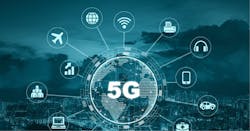The Impact of 5G on Healthcare

Across nearly every vertical, the 5th generation of the mobile network stands to revolutionize everyday business. Even before the onset of the COVID-19 pandemic, nearly 50% of US employees worked from home at least 2.5 days each week. With 5G, remote network-related tasks, such as online sales demos or sharing large files in the cloud, will become faster and more efficient. This will ultimately boost productivity and accelerate sales for businesses.
Additionally, 5G will create huge opportunities for innovations across the Internet of Things (IoT). Driverless cards, virtual and augmented reality, artificial intelligence, remote-controlled machinery, and more will give businesses willing to adopt new technology a competitive edge. For healthcare organizations as well, 5G will create new opportunities for innovation and hold the possibility of increased access to care.
Read More: 10 Fun Virtual Team Building Activities Remote Workers Love
What is 5G?
The 5th generation of the mobile network, or 5G, is a unified, more capable air interface that has been designed with an extended capacity to enable next-generation user experiences and services.
Right now, most people are familiar with and using 4G. 4G phones first appeared in the US around 2010, but 4G applications, such as Snapchat and Uber, didn’t crop up until the early 2010s. Video calls over LTE networks weren’t widespread until 2013.
There are three main kinds of 5G—low-band, mid-band, and high-band. The US bet on low-band and high-band airwaves when mid-band was ultimately the best option which means the government has some catching up to do. While we’re starting to see some adoption of 5G now, you can expect major 5G applications to start being more prevalent in late 2021 or 2022.
With the widespread adoption of 5G, we can expect higher multi-Gbps peak data speeds, ultra-low latency, improved reliability, increased network capacity, and wider availability.
5G antennas can connect exponentially more devices than previous network generations.
How will 5G change healthcare delivery?
For many healthcare organizations, the advent of broadband made secure data sharing a possibility. Patients were able to benefit from enhanced care networks with doctors, pharmacists, social workers, care givers, and others thanks to being able to share critical health data over broadband.
5G stands to empower patients to take control of their health. With the adoption of 5G, we will likely see new medical technologies roll-out that allow patients to reliably measure and monitor their health from home. Patients will be able to quickly share this data across the 5G network as it is expected that on a 5G network users could load a webpage and download files up to 100 times faster than current speeds. This could ultimately empower patients to more efficiently use patient portals, view lab results and images, access remote care, and find care plan information.
Read More: How Patient Empowerment Can Improve Health Outcomes
The COVID-19 pandemic has massively increased the demand and availability of telehealth options for patients, and it is likely that telehealth will continue to be offered as a primary source of care for many patients. 5G will support this transition to remote care by providing more reliable connections to facilitate the transfer of patient data. This will better enable healthcare providers to make quick and data-driven health care decisions remotely.
Another key benefit of 5G is the sharing of large images and files. 5G could pave the way for wireless X-ray and MRI operations. And it can also play a role in supporting augmented and virtual reality tools for training in complex medical scenarios.
Lastly, the push for 5G connectivity happens to coincide with significant growth of the wearable tech industry. Fitness watches and other wearables are very popular amongst consumers, and the advent of 5G wearable devices could allow providers to gather real-time data to predict adverse health events and build individually-tailored care plans for patients.
What are the barriers to 5G adoption?
Today, broadband is considered essential infrastructure, but many rural hospitals and healthcare organizations continue to operate without access to broadband. Access to broadband is known to directly and indirectly impact a wide range of conditions that impact health and life outcomes, known as social determinants of health (SDOH). We can expect 5G to do the same once it reaches patients.
However, the transition to 5G won’t happen overnight. Currently, smartphones aren’t even compatible with 5G—though Gartner forecasts that 221 million 5G smartphones will be sold by the end of 2020. Additionally, only a limited number of metro areas offer 5G to consumers.
Even for healthcare organizations with broadband connectivity, there is a long road ahead. Healthcare organizations will need to evaluate their infrastructure and devices to address possible roadblocks and plan for a future with 5G.
It’s hard to know what to expect from 5G. The healthcare industry is constantly growing and improving. This technology has the potential to revolutionize patient empowerment and home health. In the not-so-distant future, we may see innovations, such as “tele-presence,” where a surgeon watches a real-time operation to provide expertise and support, and even “tele-surgery,” where the doctors actually operate surgical devices remotely.
However, 5G is not without opposition. When adopting 5G, businesses, healthcare or otherwise, must prepare to adapt their security protocols accordingly to keep sensitive data secure.
Want to learn more about supporting your business with agile workflows? Check out our webinar Buyer’s Guide for Agile Workplace Software to make sure you’re choosing the right solutions for your business.




